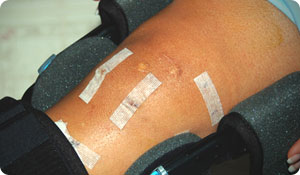
Many athletes are all too familiar with Anterior Cruciate Ligament (ACL) injuries, but now scientists is bringing some fresh ideas to traditional treatment options. Stem cells in bone marrow are proving effective in helping athletes recover from ACL surgery.
The knee is made up of three bones (the patella, femur and tibia) and four ligaments that hold them in place, allowing the knee to operate as a hinge. One of those ligaments is the ACL. An ACL injury happens when it is over-stretched or torn, frequently during sports or due to trauma. The result is pain, swelling, and instability of the knee.
When the ACL is torn, it will usually require surgery to repair or replace it since the ligament can't heal itself. ACL reconstruction surgery takes a tendon from either the knee or hamstring (either a patient's own or from a donor) and uses it to replace the damaged ACL ligament.
That's where the new research comes in. Surgeons at Orthopedic Arthroscopic Surgery International in Milan found that combining standard ACL repair techniques with bone marrow stimulation helps restore stability and function in athletes with acute partial ACL tears by allowing surgeons to use the patient's damaged ACL for the repair. That means surgeons can avoid removing the patient's healthy hamstring or patellar tendon (as is the standard ACL surgery technique) and the potential problems associated with that. The goal of the new technique enhances natural healing processes to regenerate the partially torn ACL. Essentially, the surgeons allow patients' bodies to heal themselves.
Their findings, published In The American Journal of Sports Medicine, noted that standard ACL reconstruction has about an 80 percent success rate.
To determine whether ACL repair combined with bone marrow stimulation of the ACL could bump up that success rate, researchers tested the technique in 26 athletes (ranging from 17 to 37 years), all with confirmed partial ACL tears.
During surgery, doctors sutured the ACL tear and then created small holes around the remaining healthy part of the ACL. The idea behind these holes was to facilitate release of the patient's own mesenchymal stem cells (immature cells that become bone cells) from the bone marrow in order to promote healing.
After surgery, all patients followed up with a rehabilitation program. The result? The majority saw marked improvement in ACL functioning and improved knee stability. Only five athlete-patients (19 percent) did not return to the same level of sports activity (for three, it was a personal choice).
With so much controversy present in stem cell science, this study highlights the healing potential of stem cells generated by our own bodies and offers athletes an optimistic option for surgical repair.
Resources:
http://www.reuters.com/article/healthNews/idUSTRE53N41120090424
Medline Plus
http://www.nlm.nih.gov/medlineplus/ency/article/007208.htm
American Journal of Sports Medicine http://ajs.sagepub.com/content/37/3/571.abstract





